Alopecia
Alopecia is the name used for a condition commonly known as hair loss or hair shedding. However, we first must know that not all hair loss indicates alopecia. There is also normal shedding of hair (up to 100-150 hairs per day) which is natural and simply a part of its growth and development.
Hair grows in cycles, and the human hair life cycle has 3 phases:
- anagen phase – this is the phase of hair formation. At this stage, the hair itself is soft and sensitive before it comes out of the follicle, when the hair comes out of the follicle it keratinizes and takes on the shape we all know.
- the catagen phase – is the growth phase, it is also the longest phase that represents 90% of the hair’s life cycle.
- telogen phase – the last phase that represents the death of the roots and hair loss. When the root dies, such hair remains on the scalp for up to 3 months. During this time, new hair is already forming underneath it and causes the dead hair to fall out, starting a new cycle again.

Under normal circumstances, such hair (in the telogen phase) is 6%, in the period of intensive renewal in autumn and spring up to 10%, but when the root of the hair in the telogen phase exceeds 10% and reaches 15-20%, we can say that we have a case of abnormal loss or hair loss.
Hair loss is a problem that can equally affect both men and women. The previously mentioned normal hair loss, which is part of natural hair regeneration, can be impaired, intensified, and accelerated by various factors such as stress, organic-health problems, improper health habits, inadequate skin and hair hygiene, as well as genetic and hormonal factors, etc. so alopecia can occur as a result of one or more of the factors mentioned.
In this regard, we can say that alopecia refers to any unnatural and increased hair loss that can result in baldness. Hair loss is unnatural when the hair no longer grows in the same number or thickness as the hair itself. Therefore, the main symptom of alopecia is hair loss, but in addition to hair, there can also be loss of other hairs on the body, such as hair loss from the eyebrows, eyelashes, or face as well as other parts of the body.
Alopecia is not a rare phenomenon today. About half of men will experience some form of hair loss before the age of 50. Women lose their hair more often after the 50s, during menopause. However, often hormonal changes, wrong care, and bad approach toward hair can cause hair loss in women even before that time.
Such hair loss usually causes great concern to a person for aesthetic and psychological reasons, but it can also be an important sign of various body conditions and some systemic diseases. Although alopecia is not a painful condition, it can be extremely uncomfortable and greatly affect a person’s self-confidence.
Alopecia areata
Alopecia areata (pattern hair loss, circular hair loss) is classified as nonscarring focal hair loss. Alopecia areata can affect any hairy region on the body and manifests itself in a different pattern of distribution. The prevalence in the population is 0.1%-0.2% and it can occur at any age, from birth to later life.
Alopecia areata – what it looks like and what are the symptoms
Alopecia areata is most often asymptomatic (only a small number of people have a burning or itching sensation in the affected areas), so it often happens that people do not even notice alopecia, but hairdressers or house residents point it out to them if these changes are in unseeable places for themselves.
It most often occurs on the capillitium, it can occur on the beard in men, as well as on the eyebrows. Alopecia areata is characterized by the appearance of circular areas without hair. The skin in those places is white, and smooth, without sores, blisters, redness, or scars. It often starts at the size of a grain of wheat and can expand to the size of a metal coin. The most common visible form of alopecia areata is the appearance of one or more circular or oval areas without hair. Although alopecia areata is a benign change, it causes people to feel shame and embarrassment and therefore causes great emotional and psycho-social stress.
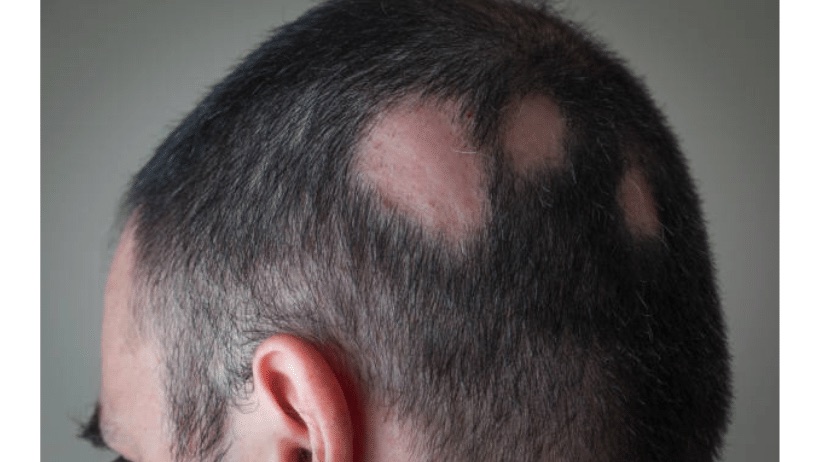
Alopecia areata – what types are there?
Alopecia areata can be classified according to the following distribution patterns:
- reticular alopecia areata – when the hair loss is excessive and there is a confluence of fields
- ophiasis – when the hair loss is on the sides and the lower back part of the capillitium
- sisaipho (reverse ophiasis) – when the side and back part of the hair is preserved
- alopecia totalis – when there is 100% loss of hair on the scalp
- alopecia universalis – when there is a complete loss of hair on all hairy parts of the body.
Causes of alopecia areata
Although the exact pathophysiology of alopecia areata remains unknown to this day, one of the most widely accepted hypotheses is that alopecia areata represents an autoimmune condition mediated by T lymphocytes, which is most likely to occur in genetically predisposed individuals. Autoimmunity, genetics, cytokines, innervation, and circulation are some of the reasons that have been linked to alopecia areata and their connection is still being investigated.
In any case, the causes of alopecia areata are most often hidden in:
- hormonal disorders (disorders in the functioning of the thyroid gland, pituitary gland, adrenal glands or gonads, polycystic ovaries…)
- disorders of the nervous system (suffered and experienced severe stress, shock, loss, and death of a close person…)
- various infections in the head and neck area (such as dental granuloma, sinusitis, ear infection, and angina…)

Therefore, when alopecia areata appears, it is advisable to check the mentioned causes, because there is always a focal point in the body itself. It is also important to understand the cause of alopecia areata because it can appear in different places, several times during the year.
Treatment and therapy of alopecia areata
It is important to emphasize that if alopecia areata is present from birth, it is not possible to permanently eradicate the problem. If it appeared recently, or if it lasts between 6 months and a year, the hair may grow back. This is especially true if solving the problem is supported by the correct treatment. Stress caused by the modern way of life, various health problems, family situations, stress at work, and similar situations can significantly worsen the problem with alopecia areata.
If the follicles remain inactive for a long time, the hair can no longer grow. And therefore, it is necessary to act as soon as possible, before the atrophy of the follicles because after that the condition becomes irreversible.
In the treatment and therapy of alopecia areata, the following are used:
- various corticosteroids in the form of gels and lotions
- intralesional corticosteroids application
- systemic corticosteroids administration
- immunosuppressive drugs
- immunomodulatory drugs
- cryotherapy
- UV ray exposure
- vasodilators
- B group vitamins
Concentrates based on natural and essential oils have proven to be particularly effective. Such extractions contain phytoestrogens, such as Serenoa repens, pygeum africanum, and hops. Their task is to stimulate physiological hair growth.
In addition, some extractions contain vasodilators such as ginger, methyl nicotinate, and benzyl nicotinate that stimulate microcirculation. They nourish the hair roots through blood vessels and capillaries, while the active plant stem cells in the extractions stimulate intercellular processes, thus acting against hair loss, as well as against the aging of follicles and dermal papillae.
Androgenic alopecia
Androgenic alopecia is the most common form of progressive hair loss. Irreversible and hereditary, it is caused by male sex hormones androgens, which are also present in women. It is usually inherited through the female line (from the mother) who can also be a carrier, and who does not have a problem with androgenetic alopecia.
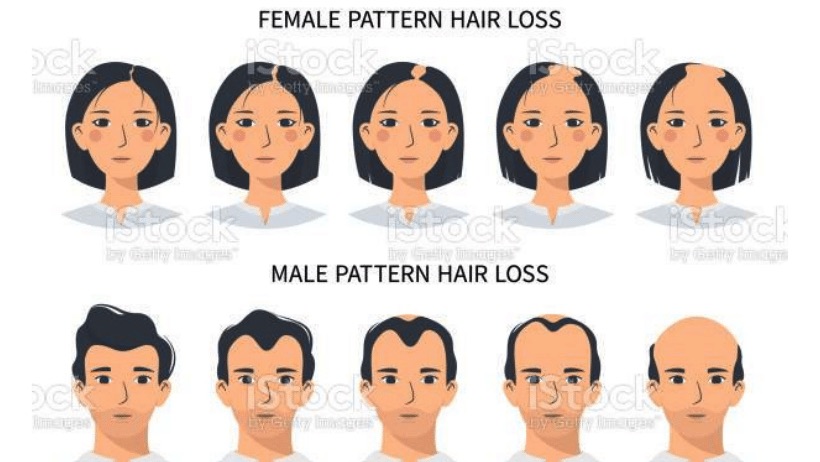
An increased level of androgens in the follicle leads to hair growth phase shortening, as well as to the delay in the growth of new hairs that should replace the lost hair. About 20% of the roots are in the telogen phase, the follicles disappear quickly, that is the balding process is accelerated.
Androgenic alopecia affects the front and center of the head where the hormone receptors are located. The main culprit is the male hormone testosterone, which is converted into dihydrotestosterone, which consequently causes root atrophy and hair loss.
Androgenic alopecia in men begins mainly between the ages of 18 and 20, during the period when hormonal development reaches its peak, and ends around the age of 36, with complete baldness on the central part of the head. Topical and oral treatments can only slow down the process, postpone it for a few years, but not stop it because the final result is written in the DNA.
In men, androgenetic alopecia is manifested by typical male pattern baldness. It all starts with a receding hairline, complete loss of hair on the sideburns, and finally ends with baldness that leaves only a rim of hair around the head while the crown is bare. In women with androgenic alopecia, the hair becomes very thin, fluffy, and thin all over the head, although the front hairline does not usually recede.
Also, compared to men, women are naturally protected by a large amount of estrogen in the body, which has an antagonistic effect on androgens. However, there are two critical periods for a woman with androgenetic alopecia. The first is after childbirth, and the second is in menopause.
Namely, during pregnancy, a large amount of estrogen is present in the body, which returns to normal after childbirth, so this hormonal variation is always the cause of hair loss. After giving birth, a woman loses her hair due to the lack of some minerals (primarily calcium and iron), which occur as a result of breastfeeding.
During menopause, the concentration of estrogen in a woman’s body decreases, while the amount of androgen remains unchanged, thus gradually there is more androgen than estrogen. Menopause is certainly not an easy period for a woman, because, in addition to hair loss, a woman faces numerous other changes that the body goes through (hot flashes, mood swings, insomnia…).
It is true that androgenic alopecia is an aesthetic problem for both sexes and can significantly affect their self-confidence, but not all people will turn it into a psychological problem and despair about it. What will make the difference is the person’s attitude and acceptance of themselves despite their natural “flaw”. Most people will do something to try to slow down the process and keep as much hair as possible, putting effort and time into finding ways to achieve this.
There are, of course, several ways, and treatments based on phytoestrogens have proven to be particularly effective, these are key because they block the enzyme alpha-reductase, which converts testosterone into dihydrotestosterone, which causes the problem.
Alopecia in children
Hair loss in children can be a very traumatic experience for both children and parents. This problem harms the child’s delicate psyche and self-confidence. Today, hair loss in children is becoming more common, and an increasing number of children are facing the problem of hair loss. Statistics say that about 3% of children experience this unpleasant situation. The good news is that with a good diagnosis, most of these children can be effectively treated.
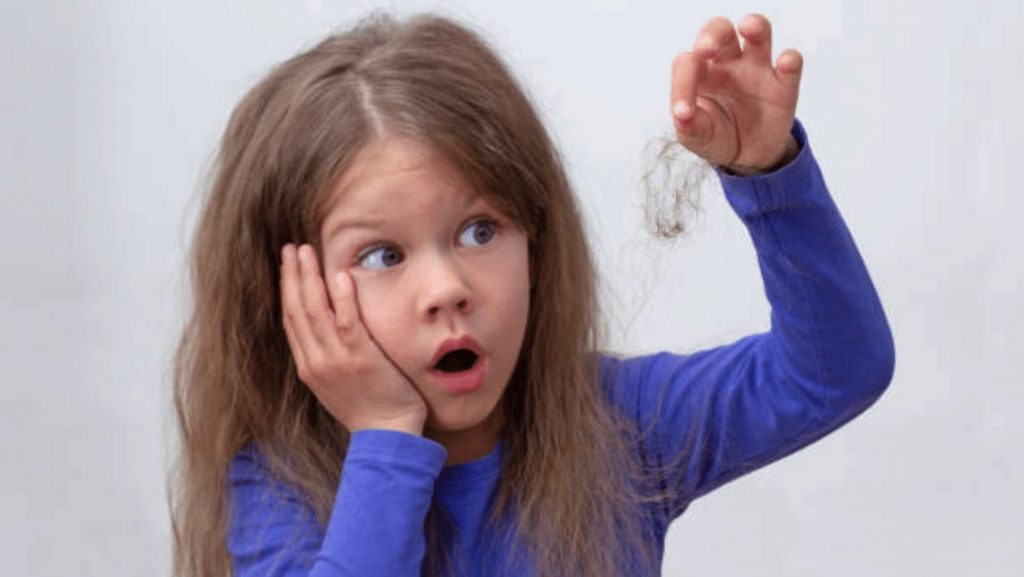
Hair loss can have different causes, and the most important thing is to determine the reason for hair loss. The reasons for hair loss in children are different and individual. However, several of the most common causes of alopecia in children differ:
- telogen effluvium – sometimes children react to a great emotional or physical trauma with increased hair loss. Surgical intervention, high temperature, experienced fear or stress, restrictive diets, sudden weight loss, and various therapies can interrupt the cycle of hair growth (put them in the telogen phase). This condition is temporary and transitory, so most often the hair grows back on its own after 6 months to a year.
- alopecia areata – recognized by the characteristic hair loss in the form of round seals. It is an autoimmune disease, and in many children, the hair grows back. 5% of children develop Alopecia totalis or Alopecia universalis, which means complete loss of hair on the head and the entire body. Parents and children should know that a child who has developed alopecia areata once tends to react to stressful situations throughout his life by losing hair in patches, so perhaps the help of a psychologist should be sought so that the child can learn to deal with stressful situations in time.
- tinea capitis – this is a fungal infection of the scalp that is often found in children. White, dandruff-like keratotic deposits can be seen over the entire surface of the scalp. These changes are most often round in shape, itchy, and the hair on these regions is broken and looks like black spots on the skin. It is highly contagious and easily transmitted, and that is why it is most prevalent in school-aged children. It is encouraging that tinea capitis is easily treatable with antifungal therapy, but you have to be consistent and persistent in its application. Because of this and other scalp infections, it is not recommended that children share bedding, towels, combs, hats, hairpins, and the like.
- traction alopecia – it is noticeable in the front hairline that recedes and is caused as a result of mechanical trauma to the hair. It is caused by too tight buns, tails, braids, barrettes, popular braids, hairpins, and dreadlocks. However, hair and scalp trauma is also caused by chemical preparations and heat devices for hair styling. In this way, hair follicles are damaged, and hair loss occurs, most often in girls.
- trichotillomania – this is hair loss that occurs if a child persistently pulls, twists, and pulls their hair. It is an obsessive-compulsive disorder because the procedure is constantly repeated. There are regions without hair or those where the hair is broken. Areas without hair are usually seen on the side of the child’s dominant hand. The child feels extreme tension before pulling out the hair, so the very act of pulling out brings a kind of relief. It always starts with some stressful situation in the child’s life. Therefore, you should not scold the child for doing this, but with the help of a psychologist, patiently treat this very serious condition. Trichotillomania is the only psychological illness that affects the hair.
- nutritional deficiency – the lack of certain nutritional elements in the diet leads to gradual hair loss. Nutrient ingredients such as protein, vitamin H (biotin, vitamin B complex), iron, and zinc are extremely important for hair growth and health. In some cases, hair loss can also be a symptom of excess vitamin A. A well-balanced diet for a child will certainly lead to healthy hair development. Hair loss is always accompanied by conditions such as anorexia and bulimia.
- endocrine causes – in some children, hypothyroidism can also be the cause of hair loss, a condition that occurs when the function of the thyroid gland is reduced, as well as the level of its hormones in the body. The diagnosis is made by analyzing thyroid hormone levels and ultrasound examination.
- newborn hair loss – many newborns lose their hair in the first few months of life, and this hair loss is completely physiological when baby hair is replaced by permanent hair. Also, some babies between 3-6 months of age have hairless areas due to leaning on a crib or car seat. As soon as the child starts to sit, the hair comes back.
- chemotherapy – hair loss that occurs in children with cancer is caused by chemotherapy, not by the cancer cells themselves. After the therapy and recovery, the hair is restored. The child can get a wig until the natural hair comes back, to make it easier for him to get through this difficult period.
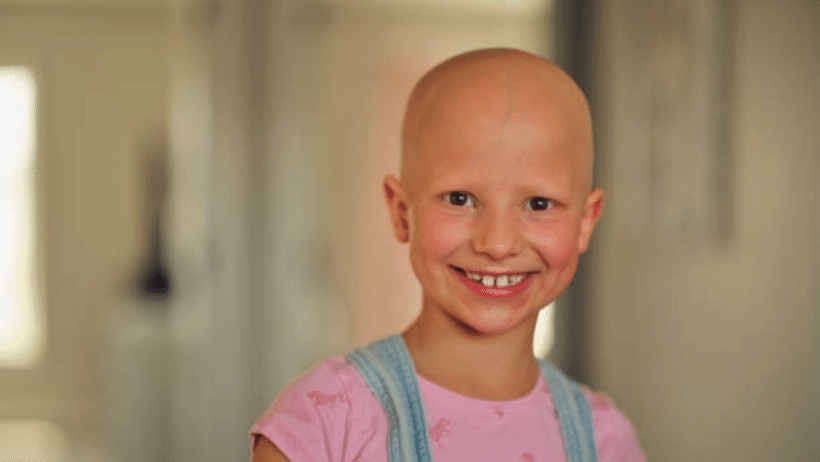
Hair loss
Hair loss is a disorder that is approached systematically, and diagnosis is the first step in starting treatment. Systematic, individual, and comprehensive analysis is necessary for every patient. Also, determining the right diagnosis establishes a relationship of trust between the patient and the specialist. For a successful treatment outcome, trust in the specialist’s competence is extremely important. There are several ways to treat hair loss, and to establish the true cause of hair loss or thinning, the most appropriate diagnostic method must be used.
We notice the first signs of hair loss or thinning when more hair falls than grows. At the same time, changes occur, such as thinning of hair in certain places, or on the entire surface of the scalp. If you notice this in yourself, maybe you should take it seriously. If you have a problem with excessive hair loss, it is recommended that you urgently seek the help of a specialist.

Normal hair loss is considered when you lose an average of 100 to 150 hairs per day. Daily shedding of hair to a certain extent is quite normal. The usual normal amount of hair shedding can be seen daily by the number of hairs left on the hairbrush. If the amount of hair on the brush suddenly increases significantly compared to the usual amount you are used to, you should face the fact that for some reason your hair is starting to fall out rapidly.
The causes of hair loss can be numerous, and one should pay serious attention to the problem as soon as possible. Hair loss and thinning can be caused by some less worrisome factors (for example, the lack of certain vitamins and minerals in the body), up to very serious causes, such as certain health problems.
Hair loss can also occur due to stress (physical or psychological), due to poor nutrition, or due to the use of incorrect or low-quality cosmetics for hair and scalp care. To establish the real cause of the hair loss problem, it is necessary to do a specialist scalp examination.
During a specialist examination of the hair and scalp, the following things are taken into account:
- hair quality
- hair density
- overall appearance of the hair and scalp
- appearance of thinned hair regions
- appearance of the scalp
- dermatological changes (psoriasis, seborrhea, lichen planopilaris…)
- presence of scars
- other changes in the hair and scalp.
To determine the true causes of hair loss, in some cases, it is necessary to examine other parts of the skin and to determine the appearance and density of hair on those parts.
What you need to know is that hair loss is not always related to health problems. Sometimes it is enough just to change some habits, reduce stress, or change hair care products, and soon there can be a significant improvement in the condition and cessation of hair loss. However, if you notice that your hair is falling out or thinning, our advice is to consult a specialist first, just in case, for professional help.
Hair loss – the cause
For many, only partial loss is associated with hair loss. The cause may be simple to eliminate, but in some cases, hair loss is caused by metabolic disorders or health problems. Total hair loss is not a common occurrence, and it is an extreme form of hair loss for which there must be a very serious reason. For this, medical help is necessary so that tests can determine exactly why this has happened.
Commonly, hair loss is a phenomenon that is much more common in men than in women. However, in recent times, hair loss has been occurring more and more often in women as well. There are many reasons, from those that are simple and easily solved, to serious health problems that can become the cause of complete baldness. Below we will list some of the most common causes of hair loss in both men and women.
Hair loss due to hormones – Hormonal imbalance combined with possible genetic inheritance is one of the most common causes of male pattern baldness. In women, again, female sex hormones can be the cause of thinning hair or baldness. In women, thinning and more intense hair loss can occur, for example, during pregnancy, but also when taking contraceptive pills, or if there is any form of hormonal imbalance.
Genetics – Androgenic alopecia is a female form of the previously mentioned onset of male pattern baldness. In women who have a family hereditary factor, and where female family members started losing hair at a certain age, there is a high probability that younger family members will also have problems with hair loss. This is because in most cases there are genetic predispositions that at a certain age, as with older family members, their hair begins to fall more noticeably. Unlike male pattern baldness, hair loss in women is generally manifested as uniform thinning over the entire surface of the scalp.
Polycystic ovaries – In women, one of the reasons for hair loss can be polycystic ovary syndrome. This is one form of manifestation of the imbalance of male and female sex hormones. In women, an excess of male sex hormones (androgens) can lead to weight gain, ovarian cysts, increased risk of diabetes, irregular menstrual cycles, infertility, increased body and facial hair growth, but also hair loss.
Thyroid gland – The decreased activity of the thyroid gland (hypothyroidism) can lead to increased hair loss. The thyroid gland is extremely important for the proper functioning of metabolism, growth and development of organs, as well as many vital functions in the human body. With proper treatments, the functioning of the thyroid gland can be restored to normal, and therefore hair loss can be stopped, as well as hair regrowth can be restored.
Anabolic steroids – Thinning and hair loss can occur if anabolic steroids are used excessively. Most often it happens with athletes who are engaged in bodybuilding. Hair loss can be permanent in some cases. Hair loss in this case occurs due to hormone imbalance (something similar to the problems women have due to polycystic ovaries).
Insufficient protein intake – Protein keratin is the main building block of our hair, and due to improper nutrition, or due to diets that require reduced protein intake, thinning and hair loss can occur. When the body does not get enough proteins that are necessary for building new and regenerating existing cells, it will automatically “decide” at one point not to supply the hair with building materials. The reason for this is that to keep the most important organs functioning, our body first “turns off” the organs that are not vital. Increased protein intake can solve this problem. Foods rich in protein are, for example, meat, eggs, fish, milk, legumes, and the like.
Vitamin A – Vitamins and minerals are necessary for the proper functioning of our body, but if the intake of certain vitamins and minerals is excessive, serious problems can occur. For example, excessive intake of vitamin A through supplements can lead to unwanted side effects, one of which is hair loss. When vitamin A intake is reduced to normal daily requirements, hair will most likely start growing again.
Vitamin B – Insufficient intake of vitamin B in the body can often cause hair loss. If this happens, changing the diet or taking supplements containing vitamin B can solve the problem. Foods that naturally contain vitamin B are meat, fish, grains, starchy vegetables, some fruits, and so on.
Anemia – About 10% of the female population between the ages of 20 and 50 suffers from anemia. This usually happens due to insufficient intake of iron in the body. Due to anemia, hair loss can also occur, and this is perhaps one of the most common causes of hair loss in women. But this problem is easily solvable. The problem of anemia can easily be solved by taking in iron naturally through food or supplements.
Stress – Hair loss caused by stress can occur due to physical stress on the body (traffic accident, severe and long illness, surgery…) or due to psychological stress (loss of a loved one, death of loved ones, divorce…). A severe stressful situation can simply block the hair growth process by causing a condition called telogen effluvium. Most often, hair loss begins only 3-6 months after experiencing a stressful situation, and therefore it is difficult to associate stress as the cause of a problem related to sudden increased hair loss.
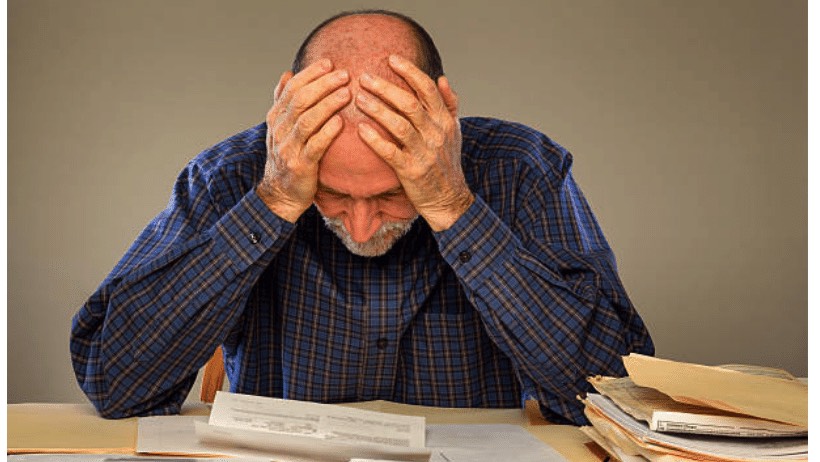
Pregnancy – Hair loss during pregnancy or after childbirth is a form of hair loss that can have several causes. Both pregnancy and childbirth are a form of physical stress for a woman’s body. During pregnancy, hair loss is most often caused by hormonal imbalances. Hair loss after childbirth is again most often caused by childbirth itself, which can be said to be quite a traumatic experience for a woman’s body. In both cases, if hair loss occurs, hair growth returns to normal after a few months after giving birth.
Hair treatments – Chemical and heat treatments can cause hair loss. Examples of this are chemical hair straightening, bleaching, hot oil treatments, and the like. Treatments with aggressive chemicals or high temperatures can directly affect the root of the hair, which can damage it. Types of hairstyles can also cause hair loss. If you tie your hair tightly in a ponytail, braids or buns, due to the constant physical pulling of the hair, hair loss can often occur.
Seborrhea and dandruff – Hair loss in seborrhea and dandruff is a problem caused by fungal infections, that is, the appearance and growth of fungi on the scalp. Hair loss occurs when inflammation caused by fungus begins to affect the hair root. Fungi can also cause itching, so frequent scratching of the scalp damages the hair follicle. This scratching is just an additional cause that will accelerate hair loss. Seborrhea also causes increased greasing of the scalp, so that the pores of the skin become blocked, which harms hair growth.
Chemotherapy – Hair loss due to chemotherapy can be caused by the effects of some drugs used to treat cancer. Chemotherapy affects all cells in the body, not only malignant cells. The mucous membranes (especially the mucous membranes of the mouth and stomach) and hair follicles are particularly sensitive to chemotherapy treatment because these cells are produced and multiply faster (as well as cancer cells). After the chemotherapy is over, the hair usually starts to grow back, but it can come back in a different color and with a different texture.
Medicines – Hair loss can also be caused by some types of medicine. The drugs that most often lead to thinning and hair loss are various types of blood pressure medications, some blood thinners, medications used in the treatment of various skin problems, some types of antidepressants, and even ibuprofen and aspirin (non-steroidal anti-inflammatory drugs).
Hair loss in patches (alopecia areata)
Alopecia areata (alopecia areata) is a widespread phenomenon of hair loss that can occur in both men and women. It cannot be said for sure why this form of hair loss occurs, but it is assumed that it is some form of autoimmune reaction of the body. If alopecia areata occurs, white blood cells attack the hair follicle, which can completely cease hair growth.
Even though even today, doctors cannot determine with certainty the reason why alopecia areata occurs, it is assumed that the hereditary factor plays a significant role. This form of hair loss occurs most often in families that have a medical history of various autoimmune diseases. Alopecia areata can also occur due to some form of stress, various types of psychological tension, or an unhealthy lifestyle.
The first symptoms manifested by alopecia areata are most often reflected in the appearance of small patches without hair. Hair loss in patches can occur suddenly and usually affects only a limited area of the scalp. Alopecia areata develops quickly, and patches of hair loss can appear within days or weeks.
Hairless circles caused by alopecia areata can be up to several centimeters in diameter. Hair loss in patches can appear as multiple smaller hairless patches, or as a smaller number of hairless patches with a larger diameter. Before the hair starts to fall out, a slight burning sensation may appear in certain parts of the scalp. Also, one of the symptoms of alopecia areata is the loss of entire strands of hair.
Although alopecia areata is a problem for many people around the world, there is currently no way to prevent it. If you notice that you are suddenly losing more hair than usual, start paying attention and monitoring the condition. Hair loss can have many causes, and it does not necessarily mean that alopecia areata is always the cause of sudden increased hair loss. If you notice any of the symptoms mentioned above, it is best to consult a specialist as soon as possible. The sooner you discover the cause of your increased hair loss, the sooner you will find an adequate treatment to solve your problem.
Hair loss after corona
Hair loss after corona has been observed in a large number of patients who have suffered from the Covid-19 virus. Most often, hair loss occurs in people with corona who had a medium-severe clinical picture, accompanied by a high temperature. Hair loss after corona manifests itself as a diffuse loss that is disturbing and psychologically stressful for people, because it happens, for example, that they find “handfuls of hair” during the shower.
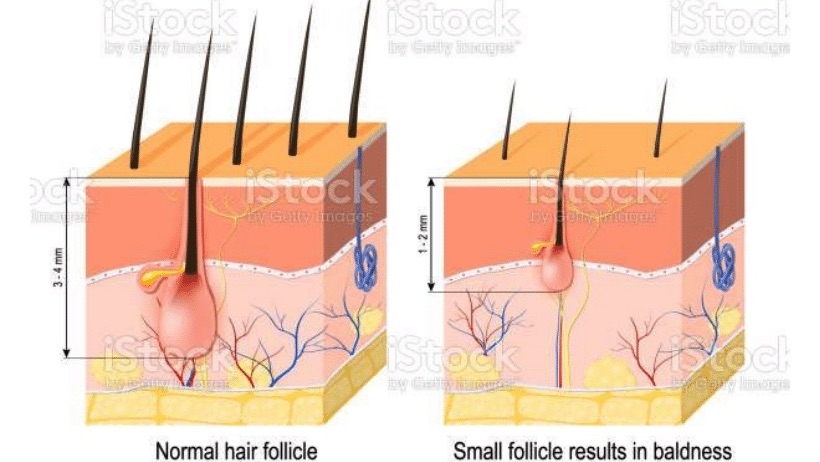
Many people after coronavirus infection, in addition to the problems and consequences it left on the lungs, heart, kidneys, blood vessels, etc., can also face problems with hair loss.
Why is this so and what is going on?
The root of the hair is connected to the capillaries through the dermal papilla, so it receives food (vitamins, minerals, amino acids…) as well as the necessary oxygen from the blood. High temperature, strong pharmacological therapy that people were subjected to during treatment (antibiotics, antipyretics…), and the covid virus itself, change the biochemical processes of blood values. Due to this, many toxins reach the roots, and they are deprived of many necessary nutrients.
That is why the life cycle of the hair is drastically shortened, so the root and the hair enter the telogen phase (dying phase). Also, when our body is in a situation to fight a serious infection, it experiences physiological stress. Then the body automatically saves on essential structures such as hair and deprives it of nutrients. As a result, the hair growth cycle is interrupted, it enters the resting phase and then the shedding phase.
It is known in science that the hair loss observed after the corona is completely consistent with a condition called telogen effluvium (TE). Telogen effluvium is a condition in which a person sheds more hair than normal. It occurs when the number of telogen hairs increases to 30 percent or more, and the person loses hair noticeably faster. TE usually passes within 3 to 6 months from the beginning of the illness from covid, so hair loss usually occurs 3 to 4 months after the covid 19 has passed. It can take several months for the hair to be renewed and grow again.
But the outcome is good in most cases. For most patients who have been through Covid, it takes a lot of patience and waiting for the hair to regenerate on its own, but it needs to be helped in different ways. It is very important to ensure enough sleep and rest, reduce nervousness and stress, eat as healthy as possible, and not only for the sake of hair but above all for the recovery of the whole organism.
The best advice we can give you regarding hair loss after corona is to be patient. The problem is successfully solved by the use of proven preparations, and adequate nutrition, as well as by strengthening the immunity of the whole organism.
How to prevent hair loss
If you want to know how to prevent hair loss, the key is hair care. Hair loss is a common problem in both men and women, and it happens for different reasons. Hair falls out when it is weakened, when it suffers and does not receive enough attention and necessary substances. Although thinning hair due to hair loss is most often an aesthetic problem, it can also be a consequence of certain health problems:
- mental or physical stress (surgery, injury, illness, rigorous diets, excessive exercise, sudden weight loss…),
- emotional stress (death of a loved one, divorce, breakup of a long relationship…),
- too much vitamin A,
- vitamin B deficiency,
- lack of minerals such as zinc and iron,
- lack of protein,
- hormonal imbalance,
- hereditary factor,
- use of certain drugs,
- bad habits in hair care,
- exaggeration with styling (blow-drying, hair pressing machine, bleach, color…),
- hospitalized with covid-19
While you may already know enough about vitamin and mineral deficiencies, what you may not know is that by improving your anti-hair loss diet, you can prevent excessive hair loss. Namely, hair vitamins are not only important for hair growth and strong hair but also prevent hair loss. Therefore, check the level of vitamins and minerals in your body in time, improve your diet, and start using supplements to prevent hair loss in time.
The most important vitamins and minerals for hair growth are hair B vitamins (a group of vitamins), vitamin A, vitamin C and vitamin D. Minerals such as iron and zinc are no less important. Improve your intake of these vitamins and minerals, and successfully prevent hair thinning. A lack of vitamin D can often be the cause of hair loss, so being outdoors to create vitamin D can also have a beneficial effect on preventing hair loss.

A balanced intake of vitamins and minerals stimulates hair growth, so you should consume food rich in omega-3 fatty acids, iron, zinc, and selenium. Foods rich in these nutritional ingredients are, for example, seafood, avocado, spinach, cocoa, red meat, and so on, and are a real benefit for the proper functioning of hair follicles.
In addition to all of the above, for the health and beauty of the hair, it is necessary to use adequate products and preparations intended to strengthen the hair. This is recommended especially in colder weather when the hair also breaks, tangles, and seems a bit lifeless. To improve the health and appearance of your hair, you need products that deeply hydrate and nourish, and thus restore your hair and restore its natural shine.
Preparations for hair growth
Shampoos – If your hair falls out to a greater extent, the hair shampoo you are currently using should be replaced with ultra-hydrating formulas based on vegetable keratin, amino acids, vitamins, castor oil, panthenol, and the like. These ingredients simultaneously nurture, nourish, strengthen and restore damaged hair.
Oils – Despite a large number of shampoos, conditioners, and products that promote hair growth and density, it has been determined that the most effective are those that come from nature, namely oils. Deep hair care cannot be imagined without nourishing oils that also have a protective role. We can apply them after washing, before, or after styling the hair. Nourishing hair oils are one of the best ways to speed up your hair growth as well as prevent excessive shedding.
Masks – Depending on the specific needs of your hair, it is necessary to choose a mask that will give you the most protection. To restore hair, it is recommended to use masks once or twice a week. In case you have problematic and damaged hair, this is not only desirable but also mandatory. Masks help hair to recover from all mechanical damage (such as drying, ironing, styling…), but also external influences (such as cold, dry air, wind…) Hair masks deeply nourish, provide nutrition and replace lost moisture. Also, they make combing easier, improve texture and make hair smooth.
Serums and ampoules – Serums and ampoules that stimulate hair growth are one of the most popular and effective ways to combat hair loss. They act directly on the root of the hair because they stimulate circulation, which is responsible for the exchange of oxygen and nutrients. Follicle stimulation is vital to the process of renewal and new hair growth. These ampoules help reduce hair loss, help care for, and strengthen the hair structure.
Hair peeling – Recently, peeling is increasingly being used to prevent hair loss. It removes impurities and dead cells from the scalp and allows the scalp to breathe. This increasingly popular method recovers hair from the consequences of chemical and mechanical effects, and besides preventing the scalp from becoming oily, dandruff, and itching, peeling prevents unwanted hair loss and encourages faster hair growth.
